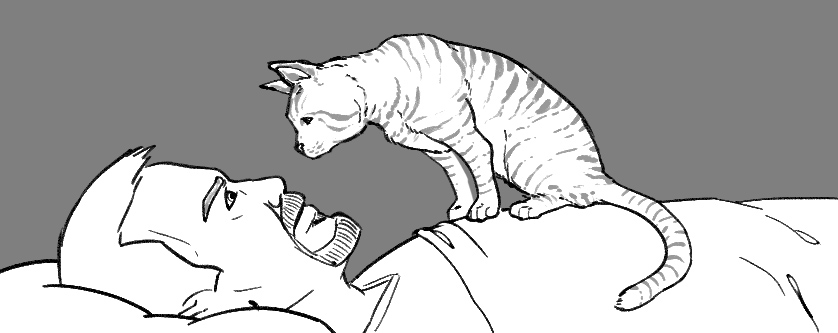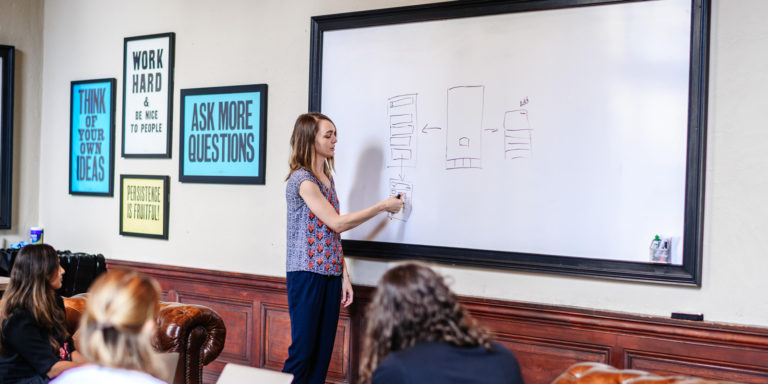The Creative Process Needs Time to Stare into Space

A few months ago, I felt like I was in a rut on one of my projects. Each morning I would stare at all of my notes, sketches and diagrams for half an hour. That’s all I could do. I was blocked.
One morning, our senile cat woke me up at 4AM and I couldn’t get back to sleep. As I stared at the ceiling, I started to think about my creative block and I had a revelation. It started with a single thought, then some ideas and eventually I had to get out of bed and take it all down.

The Value of Letting Things Sit
I formed a habit as an English major in college: I would write a paper a week before it was due, then put it away. A day before I handed it in, I’d revisit the paper and rewrite it. I needed that time to digest my thoughts and let them mature. I was never the one staying up until 5AM the night before a paper was due, I was the one staying up until 5AM a week before it was due. I follow a similar pattern with many blog posts, writing them weeks or months ahead of time, then revisiting them when I can read them as a new reader rather than as the author.
Early in my career, I was a writer/instructional designer on a series of multimedia products focusing on management and leadership. Our lead consultant would ask us to put everything down into a document he could read on the plane and let it “percolate.” It was frustrating to think his busy travel schedule was delaying my work, but he had the seniority, so that’s what we did. At some point during that week we’d get an email with a marked up version of our document and we’d move on.
An informal survey of my friends in other design fields confirms this. Sometimes you just need to sit and stare at a problem before the solution comes to you. It’s not about being a temperamental artist, it’s about giving your brain time to process.
Creativity and Time
The evening before my revelation, I had just finished watching the documentary El Bulli: Cooking in Progress. Since the 1960s, elBulli has been a respected restaurant in Spain, just outside of Barcelona. In the 90’s it gained critical acclaim under the direction of Chef Ferran Adrià, but never succeeded commercially. It closed in 2011.
The film follows Chef Adrià and his team in their gastronomy lab during its traditional six-month closure when the new menu was developed. It is a must-see for anyone interested in studying the creative process, folks who have worked in restaurant kitchens, or people who just like watching food being made.
The film opens with two of Adrià’s chefs debating the best way to extract the essence of a sweet potato: juice-then-cook, or cook-then-juice? Throughout the film, Adrià is pacing around the kitchen, poring over notes and calendars and talking on his cell phone. Occasionally a chef approaches him with a spoon. He tastes, scowls, offers an adaptation and the process continues. Not only is this method ripe for conflict, it appears to embrace conflict as a necessary part of the creative process.
Near the end of the film, Adrià and his chefs have perfected the flavors and processes they will use to introduce their new dishes. They have not yet created the dishes, they have only perfected the components of these dishes. At this point, they bring in the extended staff and Adrià coaches them on the next six months. “Creativity and production are two different things,” he tells them. Clearly production is as important as the creative process, but they’ve flipped the traditional model on its head. The smaller creative team gave themselves months to innovate, the production staff has only a few weeks to master the techniques and serve guests.
The process Adrià and his team follow mirrors my writing habits as a student, my former colleague’s habit of letting things “percolate,” and my current habit of staring at the ceiling at 4AM to solve a critical problem. The difference is that Adrià and his staff took an immense amount of time for that percolation and thought – an amount of time that undoubtedly contributed to their lack of commercial success. Success can be measured in many ways, and in the case of elBulli, profitability never seems to have been the focal point.
In our field, time is often the rarest commodity we have—but it’s also a critical component to what we do. We often talk to our clients about the Think Space as a place where you can get away from the daily grind and “think out loud” with us. A key component to that is also the time that you allow yourself to do your thinking. Sometimes sitting and staring at an image or re-reading your notes is just as valuable as putting pen to paper.



